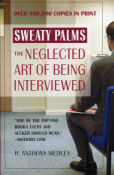| What REALLY goes on in a job interview? Find out in the new revision of "Sweaty Palms: The Neglected Art of Being Interviewed" (Warner Books) by Tony Medley, updated for the world of the Internet . Over 500,000 copies in print and the only book on the job interview written by an experienced interviewer, one who has conducted thousands of interviews. This is the truth, not the ivory tower speculations of those who write but have no actual experience. "One of the top five books every job seeker should read," says Hotjobs.com. | |
| The Art of the Steal (5/10) by Tony Medley Run Time 101 minutes. OK for children, although it will bore them to death. The Last Temptation is the greatest Treason; To do the right deed for the wrong reason. T. S. Eliot, Murder in the Cathedral. This is a hatchet job from the get-go. It’s about an autocratic, petty, arrogant multimillionaire, Dr. Albert C. Barnes, who amassed the greatest array of Post-Impressionist paintings in the world, including 181 paintings by Renoir, 69 by Cézanne, 59 by Matisse and 46 by Picasso, and basically hid them away in Merion, PA., a suburb of Philadelphia, limiting their viewing to a chosen few. Piqued by his treatment by the elites in Philadelphia, he restricted attendance and refused to loan paintings to other institutions. To be certain that very few people would be able to ever see these masterpieces, according to this film he established what he thought was an iron-clad trust prohibiting the paintings from ever leaving Merion, stipulating that the collection should "never be loaned, sold or otherwise deposed.” Then he gave control to the trustees of Lincoln University, the first black college in America. Some people challenged his trust and have tried to get the collection moved to Philadelphia and open them to a much wider audience. This film tries to paint Barnes as an iconoclastic hero and the people who have been fighting his trust to try to open the paintings to wider view as villains. But is that the way to look at it? Was Barnes a hero? Is a man who tried to lock away some of the greatest paintings in history so that they may be viewed by only a special view someone to be lionized? Are the people who tried to free them for viewing by a much wider audience to be villified? Indeed, this film is terminally biased. Just as one example, it leaves the viewer with the belief that Barnes specifically stated that the works should never be moved to Philadelphia. However, in an article, Barnard C. Watson, who is now the chairman of the Barnes Foundation board of trustees and is maligned in the movie, states that the film ignores paragraph 11 of Barnes’ trust indenture, which states, “Should the said collection ever . . . become impossible to administer the trust hereby created concerning said collection of pictures, then the property and funds . . . shall be applied to an object as nearly within the scope herein indicated . . . such application to be in connection with an existing organization . . . in Philadelphia, Pa., or its suburbs.” The people interviewed who are blasting the move to Philadelphia come across as elitist snobs with a selfish view of the world. One makes the statement that one of the paintings in the Barnes collection is worth a half billion dollars by itself. This despite the fact, unmentioned in the film, that the highest price ever paid for any painting is $150 million for a Jackson Pollock sold by David Geffen at Sotheby’s. Some of the guys painted as bad by director Don Argott are interviewed. One is Pennsylvania Governor Ed Rendell. All the interviews are mere snippets. The main issue that I can see is why in the world is it all right for a megalomaniac multimillionaire, who could easily qualify as a James Bond super villain, to buy up a vast number of great paintings and basically hide them away from the world? Isn’t it better that these paintings be located in a place, like Philadelphia, where many more people can see them than in a place like Merion where the number of viewers is severely limited to, as I understand it, just a few hundred a day? But this point is never made in the movie by any of those interviewed. I find it hard to believe that none of them mentioned this. Clearly the interviews with the targets of the film, like Rendell, are severely edited à la “60 Minutes” style and probably taken out of context in order to make the filmmakers’ point, rather than to give an unbiased view of the situation. It also contains a recurring statement that some named persons refused to be interviewed for this film." Well, maybe those named persons had good reasons not to sit for interviews. Maybe they realized they had no control over the way a biased filmmaker would make use of what they said and how what they said would be edited and taken out of context. However, what this movie tries to prove is that the people who wanted to move the collection to Philadelphia were motivated by greed. It’s not unreasonable to think that the interviews were artfully edited to make Argott’s position appear rational and their opponents greedy. This feeling is buttressed by Argott’s failing to disclose the above referenced paragraph 11. After doing a little research and reflection, this comes across as an emotionally packed piece of propaganda. In addition to being apparently dishonest, it’s too long and byzantine. Even so, it fooled my audience, who applauded at the end. But, for the sake of argument, what if those challenging the trust and trying to move the collection to Philadelphia are, in fact, motivated by greed? Is it right to criticize them for doing the right thing for the wrong reason?
|
|
|
|
|
